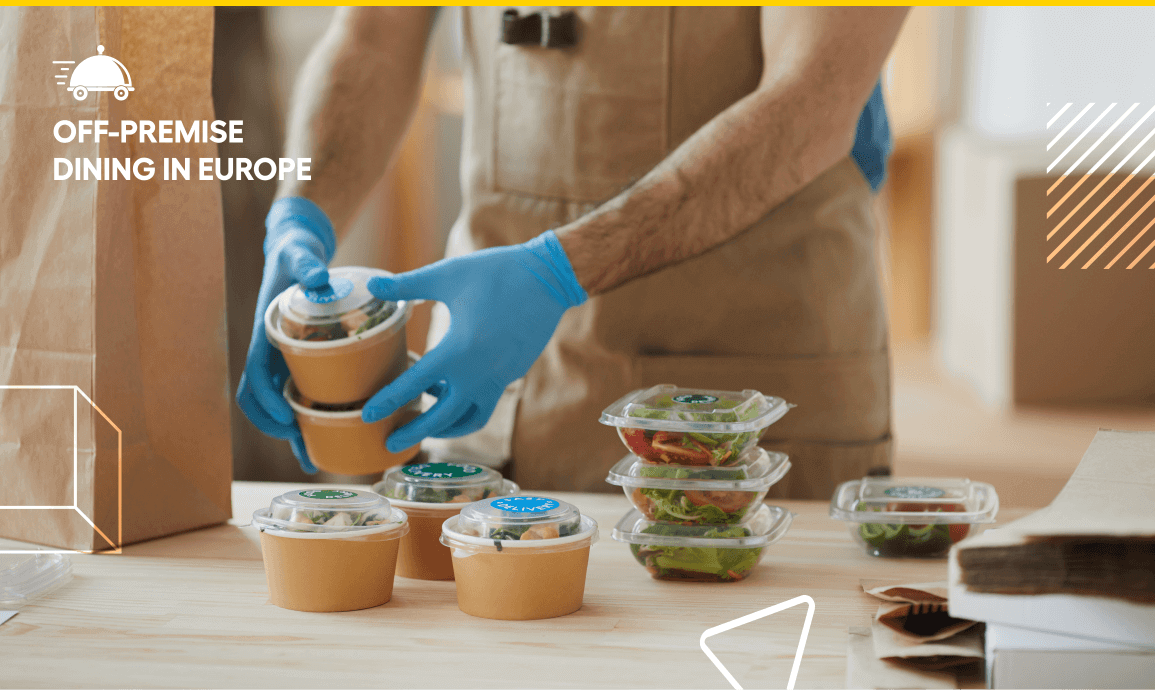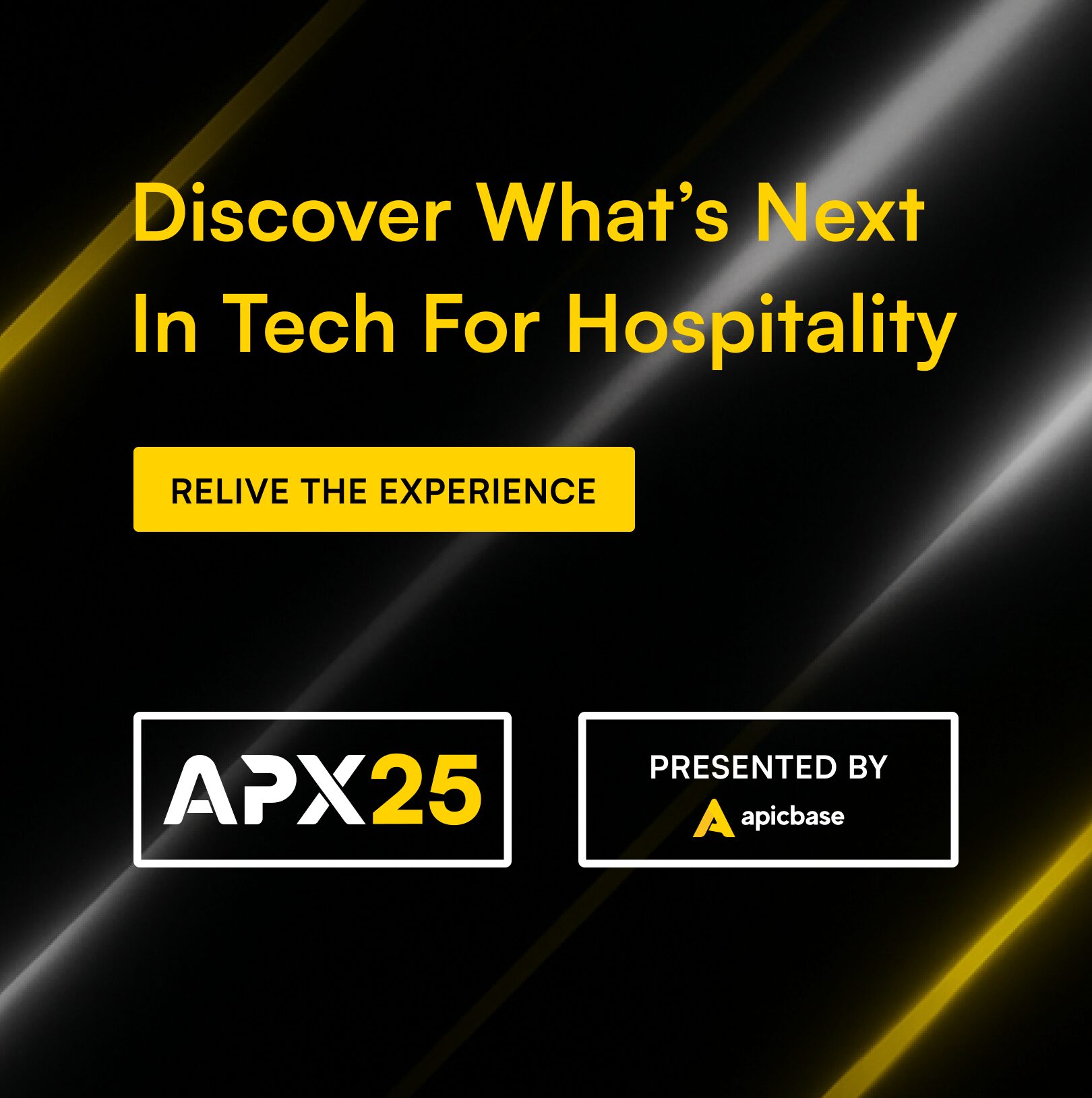Who can imagine the restaurant industry today without off-premise dining options like delivery, takeaway, curbside pickup, ghost kitchens, and drive-thru?
It’s safe to say that off-premise dining has become an essential part of consumers’ lifestyles and a massive driver of industry growth.
Even with consumers happily returning to restaurants in the wake of the pandemic, demand for off-premise orders remains high.
However, the increased demand for delivery and takeout doesn’t necessarily make it a profitable segment.
That’s why many food-service operators are now optimising their online ordering operations to make them more efficient. The aim is to develop a sustainable revenue source that can be permanently incorporated into the business model.
Additionally, food brands worldwide are looking into the ghost kitchen model – which sits at the heart of the off-premise dining channel – to meet increased demand. As a result, the dark kitchen market is evolving at breakneck speed.
The question is: which models will prove viable?
This article looks into the future and tries to predict how the off-premise dining segment will evolve.
We look primarily at the situation in Europe but that inevitably means putting the US under the microscope as well. They were quicker to test new off-premise models and have learned lessons through trial and error that companies on the other side of the ocean can learn from too.
Let’s dive into the trends and business models determining the future of off-premise dining.
Why Ghost Kitchen Models Are Evolving
Ghost kitchens – also called dark kitchens or cloud kitchens – gained notoriety roughly around the time demand for online food delivery started soaring.
While these traditional models still exist, cloud kitchen models have had to evolve to meet changing consumer needs. One development in that area is that consumers often prefer more versatile kitchens with multiple brands in their portfolio. The reason is simple. When customers order food with family, a group of friends or colleagues, a kitchen that focuses on multiple cuisines can cater to everyone’s preferences. The multi-brand strategy allows for easy consolidation of diverse orders.
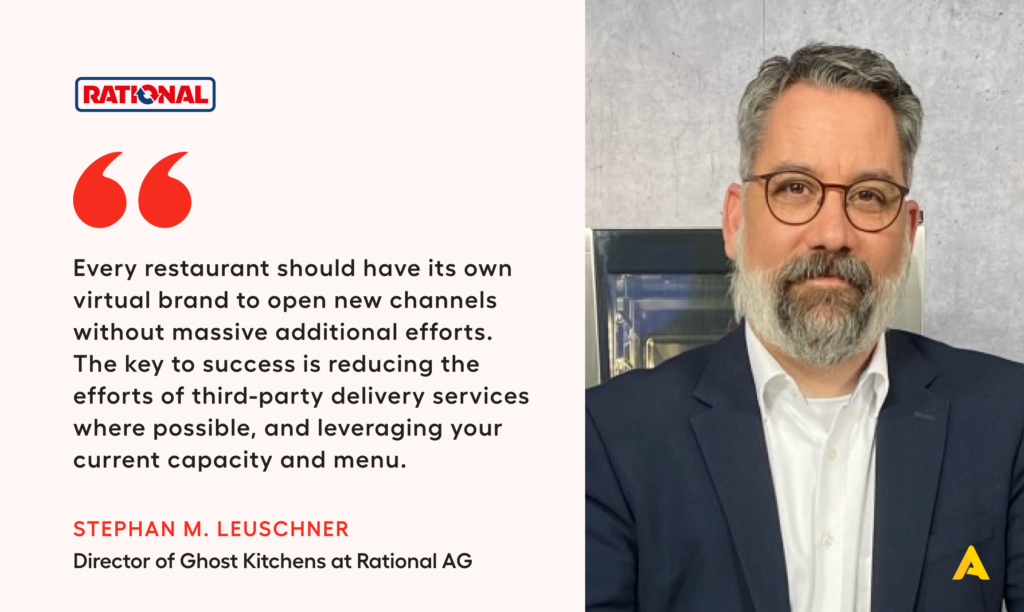
But adopting new, multi-functional business models that go beyond delivery doesn’t just help cloud kitchens accommodate customer demand. It also enables them to resolve some of the biggest challenges ghost kitchens face, like:
- Issues with last-mile delivery, such as hefty commission fees and loss of control over the customer experience;
- Lack of customer data and, therefore, personalised marketing opportunities;
- Lack of direct customer interaction and, in turn, difficulties improving guest loyalty;
- Not being a valued part of the local community.
The last item on the list may need some explanation. When ghost kitchens started popping up, many brands using them tried to keep under the wraps that their orders were coming from a delivery kitchen.
Unfortunately, the lack of transparency and ambiguous terms like ‘dark kitchen’ and ‘ghost kitchen’ created mistrust among consumers early on. So, to prove there’s nothing mysterious or sinister about dark kitchens, operators engage with and invest in the local communities they serve.
Not surprisingly, transparency is a recurrent theme among the next generation of virtual restaurants. So let’s look at a few trending cloud kitchen models and how they can help your ghost kitchen connect with customers.
Trending Ghost Kitchen Models (aka Hybrid Ghost Kitchens)
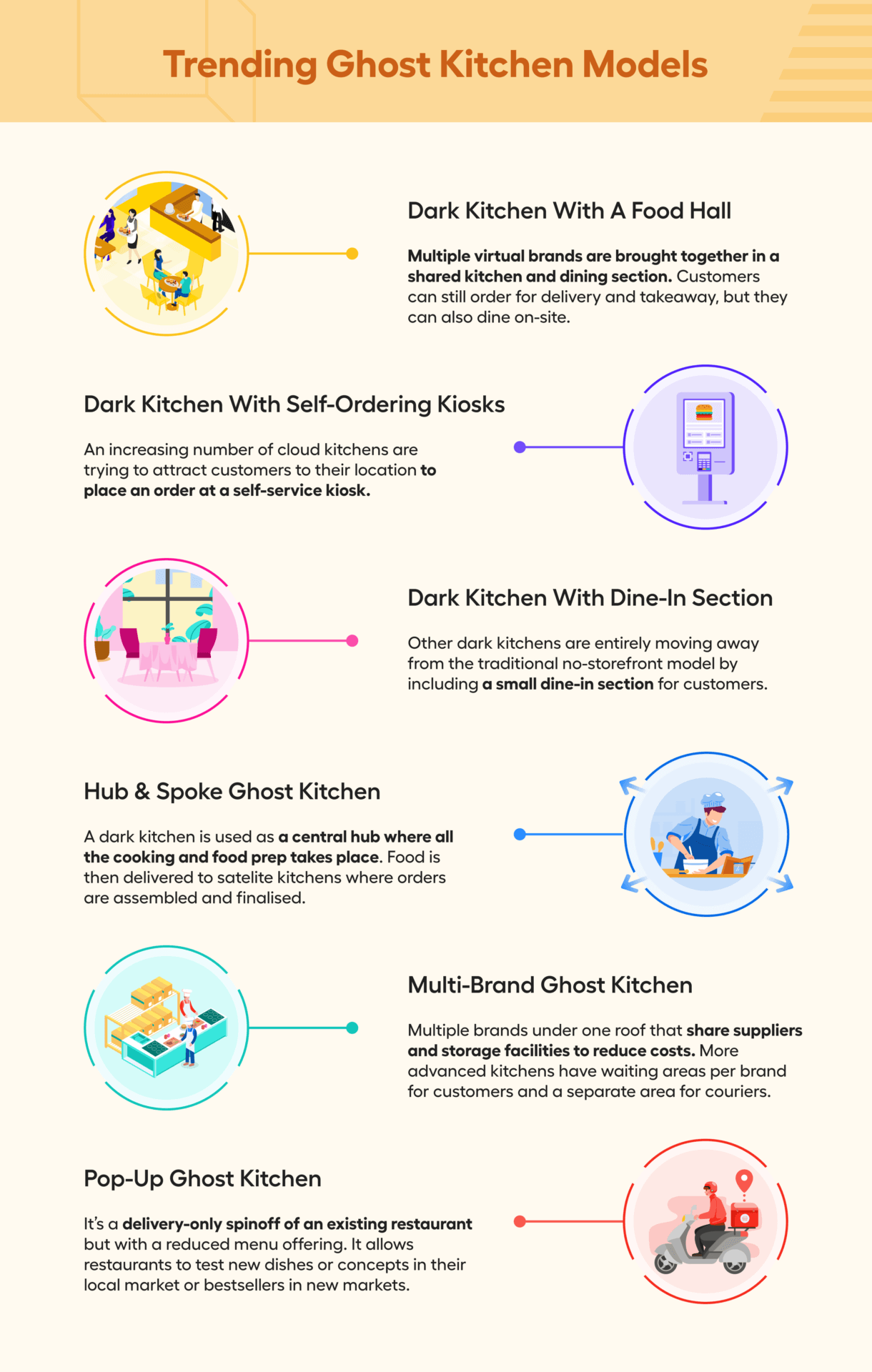
Dark kitchen with a food hall
Like DoorDash Kitchens, Local Kitchens, and Partake Collective
Last year saw the opening of some of the world’s first ghost-kitchen-powered food halls. Typically located in neighbourhoods with high foot traffic, these food halls bring multiple virtual brands together in a shared kitchen and dining section. Customers can still order for delivery and takeaway, but they can also dine on-site.
The food hall concept isn’t new, but cloud kitchen operators are using it to step out from the shadows and connect with the local community. Food halls also fit current consumers’ need for socialising and sharing unique dining experiences.
Dark kitchen with self-ordering kiosks
Like Oomi, Hungry House, and Casper
Is pickup the new delivery? An increasing number of cloud kitchens are trying to attract customers to their location to place an order at a self-service kiosk.
Pickup allows dark kitchens to physically meet guests, collect data, and learn more about their preferences to build relationships. But there’s more. By shifting towards pick-up or takeaway, you can soft sell, cut costs on delivery, and make your operation more sustainable.
Dark kitchen with dine-in section
Like Cloud Eatery
Other dark kitchens are entirely moving away from the traditional no-storefront model by including a small dine-in section for customers who want to enjoy their food straight away.
Adding a dining area is a great way to give your virtual brand a physical footprint and connect with customers. It can also help you improve profitability by eliminating last-mile delivery and encouraging cross- and upselling.
If you’re thinking of creating a (pop-up) brick-and-mortar restaurant, this business model may give you an idea of how attractive your brand is to potential customers. Just think of it as a soft launch.
Hub & spoke ghost kitchen (aka central production kitchen)
Like JustKitchen
The hub & spoke cloud kitchen or central production kitchen has rapidly gained popularity over the past few years. That’s because it boosts operational efficiency and product consistency, which are crucial for dark kitchens to succeed.
The model works as follows: you use your dark kitchen as a central hub where all the cooking and food prep takes place. Food is then delivered to your spokes, including restaurants, food trucks, food halls, etc., where it is finalised. Some hub & spoke kitchens also deliver finished products directly to customers.
This process increases efficiency and consistency, but the spokes also enable your virtual brand to expand its reach.
Multi-brand ghost kitchen
Like Reef, Zuul, and Ghost Kitchen Brands
The multi-brand ghost kitchen is one of the traditional models that has proven future-proof. From an operational point of view, it makes excellent sense to unite different (virtual) brands under one roof and share suppliers and storage facilities to reduce costs.
So far, that’s nothing new. But soon, we may see a new interpretation of this tried-and-tested model. Experts believe multi-brand cloud kitchens will become even more efficient, offering separate waiting areas to accommodate customer pickup on the one hand and delivery couriers collecting orders on the other. The customer pick-up section may have a bar, coffee corner, or even a small in-store market.
Additionally, future versions of this dark kitchen type may be more integrated into shopping centres, airports, large office buildings, universities, or other locations with high footfall and convenient parking facilities.
Pop-up ghost kitchens
Like Porchetta District (by Georgetown Gourmet)
A pop-up ghost kitchen is an appealing concept for restaurants that want to get a piece of the dark kitchen pie. In essence, it’s a delivery-only spinoff of an existing restaurant but with a reduced menu offering.
Pop-up virtual kitchens are gaining momentum because they allow restaurants to rapidly test new dishes or concepts in their local market or try out their bestsellers in entirely new ones. They have a low barrier to entry, reduce overhead costs, and minimise the pressure of online orders on the brick-and-mortar restaurant’s kitchen.
Other Trending Off-premise Business Models
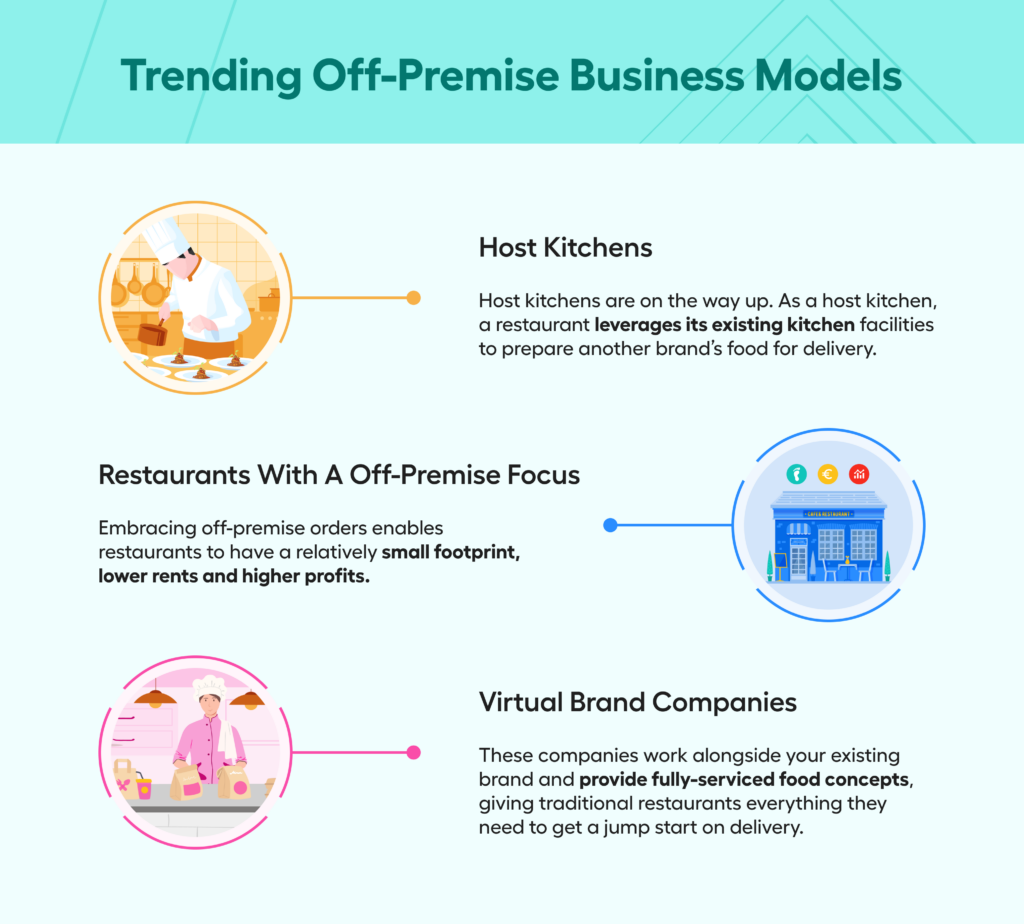
Of course, off-premise dining is about more than just dark kitchens. Amid the chaos created in recent years by unplanned, and sometimes somewhat forced, adoption of delivery by traditional restaurants, a few business models emerged that proved sustainable.
Host kitchens
Like Nextbite and Ghost Kitchen Brands
Host kitchens are on the way up. As a host kitchen, a restaurant leverages its existing kitchen facilities to prepare another brand’s food for delivery. That’s a great way to maximise your kitchen’s potential and bring in 10 to 20 percent in additional sales. In today’s dire economic situation, that’s a big win for any restaurant looking to boost profits.
Experts suggest what we’ll see next is a host kitchen collaboration between grocery stores and food brands.
Kitchens inside grocery stores are typically underutilised. To turn their kitchens into profitable assets, supermarkets could serve as hosts for virtual and restaurant brands. Some ghost kitchens already work with self-service kiosks in supermarkets, so having an on-site kitchen would be a logical next step. If there’s no opportunity to integrate a ghost kitchen into the building, that’s where grocery stores’ kitchens may seize the opportunity.
Restaurants with a solid off-premise focus
Like OLIOLI and Chipotle
One of the most common misconceptions about dark kitchens and virtual brands is that they take away from brick-and-mortar restaurant sales. That’s not the case. Consumers may prefer ordering food after a busy work day but dining out with friends on a Friday.
As a restaurant, there’s no doubt you can benefit from creating your own virtual brand for off-premise guests. You can use your existing menu or make a spinoff that works better for delivery and takeaway.
Embracing off-premise orders also enables you to have a restaurant with a relatively small footprint, which in turn allows for lower rents. That’s how brands with around 85% off-premise sales, like OLIOLI, increase their profit.
Virtual brand companies
Like Peckwater Brands and Clone (ex-Not So Dark)
If you run a brick-and-mortar restaurant and don’t want to create your own delivery concept, you can always licence an existing virtual brand. That’s an option getting more popular because it’s fast and low-risk to set up, with little upfront cost.
It’s, therefore, not surprising that virtual brand companies offering delivery franchises have been booming over the past year. These companies work alongside your existing brand and provide fully-serviced food concepts, giving you everything you need, from recipes and packaging to training and technology. They also help you hone in on your digital marketing skills and budgets required to drive sales. In other words, they set you up for success, and you can focus on fulfilling orders.
Recommended reading: How To Run a Successful Cloud Kitchen? We Asked Ghost Kitchen Operators Worldwide
How to Win With Your Off-premise Dining Channel?
Food-service operators are creating new hybrid business models to see if they meet consumer needs and operational requirements. Virtual brands, in particular, are gaining momentum. Unfortunately, that has resulted in virtual brands overcrowding delivery platforms – but not all of them are well thought out and high quality. That certainly doesn’t help virtual restaurants inspire trust.
Additionally, there’s been some turmoil in the industry when delivery couriers revealed they work in less-than-ideal conditions and when restaurants renounced third-party services’ hefty commission fees.
That begs the question: what will it take to make the off-premise restaurant industry successful? Which models will win?
The answer is simple and complex at the same time. While some business models may be more promising than others, the operators that are most likely to succeed are the ones that understand best what the customer wants:
- A top-notch experience and great value for money;
- Convenience: having restaurant-quality food wherever and whenever they want;
- A sustainable dining experience with minimal impact on the planet.
Rather than taking a one-size-fits-all approach, every operator must decide first if off-premise sales fit their brand before committing to one or more business models.
Understanding your customers comes first.
CEO and founder of Beyond Gastronomy Jan Scheidsteger, develops concepts for the hospitality industry. A brand’s success is rooted in understanding the guests and their needs. “The same is true for off-premise dining”, he says.
“When it comes to food delivery, we need to be conscious about how we will live in the next ten years to understand how restaurant businesses will adapt. I’d say there’s a growing need for snackification – going from one snack to the next to function.
However, people are no longer necessarily working 9 to 5. They’re working flexibly, from home and the office, and food delivery will have to transform to meet consumers’ needs. In the future, quality will be even more crucial to set your (delivery) brand apart.”
“In some locations, it may be easier for locals to drive five minutes and grab their food to control their timing. In bigger cities, delivering food is typically more feasible and cost-efficient. It all depends on where you are.
That’s why start-ups in last-mile delivery are trying so many different things: they want to be the first to understand what consumers want. That also means we have to start thinking further. For example, what if I work in a big office complex? How does the delivery driver find my desk? And how do I make sure I get my lunch in time so it aligns with my daily routines?”
When we look back to the trending ghost kitchen models, some concepts already tackle this issue, allowing customers to order online but also enabling them to pick up their food if they live just a few streets away.
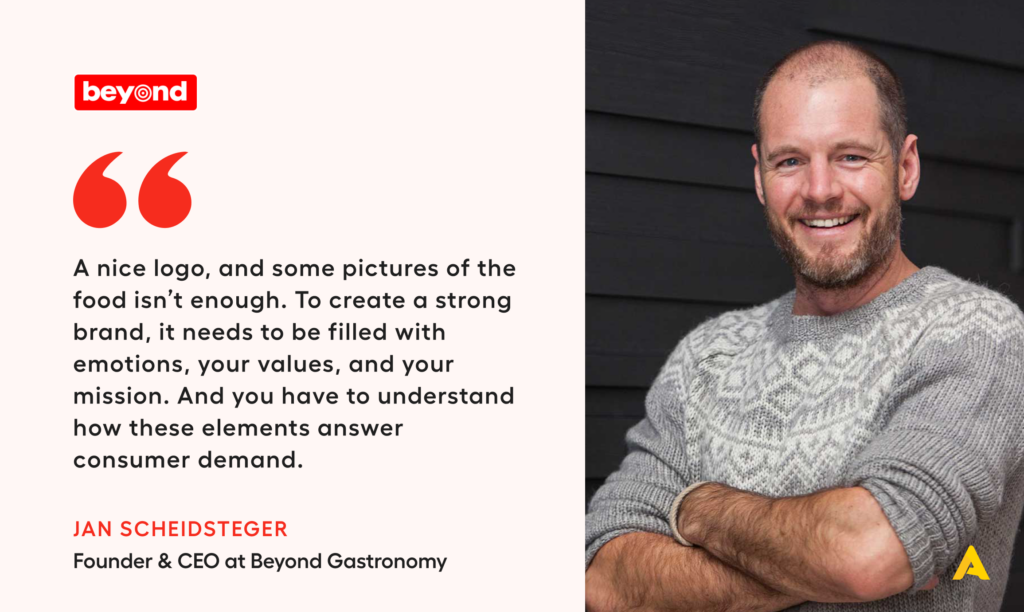
Digital marketing is crucial.
Digital marketing is essential in the online ordering segment. So as an operator, you must have online marketing skills to attract attention. Being skilled in this area helps you better understand your brand and customers.
Additionally, digital restaurants have to be where consumers are. GenZ spends up to 6 hours a day on their mobile phones, which tells you where your customers are. That means you’re missing out on selling opportunities if your restaurant doesn’t provide online ordering and takeout. We’ve collected 47 marketing tips for your restaurants in a separate post.
Simplicity in recipes facilitates better consistency.
Understanding your brand’s value and customers is crucial to success, whether you focus on in-house dining or off-premise orders. So is food consistency.
Over the past few years, countless restaurants and cloud kitchens have rolled out delivery and takeaway and created virtual brands. But there’s still huge potential to improve the quality of their offering.
Improving food quality is the next step to unlocking your full potential and creating a solid, future-proof off-premise brand. Not just once but consistently. If you don’t offer quality and consistency every single time, consumers will order from a competitor who does get it right.
Use restaurant technology as an enabler.
So, how do you ensure you understand your brand and customer? How do you recognise marketing opportunities? And how can you simplify recipe development (across multiple locations) to make your recipes count?
The answer lies in restaurant technology.
Dark kitchens have been using tech since their conception, and there’s even a saying that ‘ghost kitchens are tech pioneers that happen to sell food’. Today, they still leverage technology to accommodate consumer needs, work efficiently, and increase profit. That’s because restaurant tech eliminates and automates time-consuming or manual processes while providing valuable business insights and (predictive) reporting.
Because fulfilling orders as efficiently as possible, running a lean operation, and ensuring customers get their food fast are the cornerstones of ghost kitchens, innovative cloud kitchen management software will be even more vital in the future.
Find the right fit for your brand: first-party or third-party ordering.
Once you’ve decided you want to start offering off-premise dining options, there are a few directions you can go. The most likely scenarios are the following ones:
- Outsource the entire ordering experience and fulfilment to a third-party service like Uber Eats or Deliveroo.
- Create a first-party marketplace (aka your own online ordering system) and team up with a third party for fulfilment.
- Do everything yourself, like big pizza brands such as Pizza Hut or Domino’s.
- Combine the best of both worlds. OLIOLI, for example, uses both first- and third-party orders. As a result, they get additional sales from consumers on third-party platforms who don’t know their brand yet. The ultimate goal is to drive repeat business through OLIOLI’s app by offering customers a better experience and lower prices.
So, what’s the best option for your brand?
Without third parties, many more restaurants would have likely closed when the pandemic hit. There’s no doubt third-party delivery services are an essential cog in the machine. These companies have invested millions into attracting customers to their apps. As a result, they’re very good at acquisition.
What’s more, hungry consumers aren’t necessarily thinking about your restaurant when they’re looking to order. They may not even know your brand yet. So if you accept that reasoning, every customer you get via one of the third-party services is incremental to your own sales channels. And when orders are incremental, you can start thinking differently about the economics of the profitability of that action.

Communicating about your first-party marketplace is equally important as developing one. It’s also essential to consider which brand experience, packaging, and message you want to deliver. And if you operate a hybrid concept with a dining section, there’s no reason why your marketplace shouldn’t accommodate in-house diners, too.
In other words: whether you work with a third party, fulfil orders yourself, or combine both, depends entirely on your journey. Yet, in an ideal world, you take the latter approach to tap into as many audiences as possible!
Dynamic pricing is on the up.
Finally, future-proofing your off-premise operation may also include implementing dynamic pricing. That means you make small, incremental changes to your prices based on demand to increase revenue and offset labour shortages and supply chain issues.
Dynamic pricing also allows you to expand order-ahead options, which are more sustainable and economical. For instance, you can leverage better prices if customers order a day or week ahead. That’s particularly interesting for schools, office buildings, or housing communities. This way, you meet consumer demand for sustainability while offering the best value for money.
The Evolution of Off-premise Dining Models is Already Underway
In the year ahead, the off-premise restaurant industry will continue to evolve, with operators testing new business models to accommodate changes in the consumer’s mindset and expectations.
Trending restaurant and dark kitchen models in Europe that we’re willing to bet on to succeed are mainly hybrid concepts that offer versatility, convenience, and extraordinary customer experience. The great news is that both ghost kitchens and brick-and-mortar restaurants can tap into these hybrid models to secure additional revenue streams and new markets.
But to truly succeed and stand out, you’ll need to do more than create a virtual brand or add an online ordering channel. If you want to win, you must understand your brand and your (off-premise) customers, fully commit to the story you want to tell, ensure consistent food quality, and streamline your business to get orders out the door quickly. Moreover, you can’t lose sight of profitability while doing all the above.
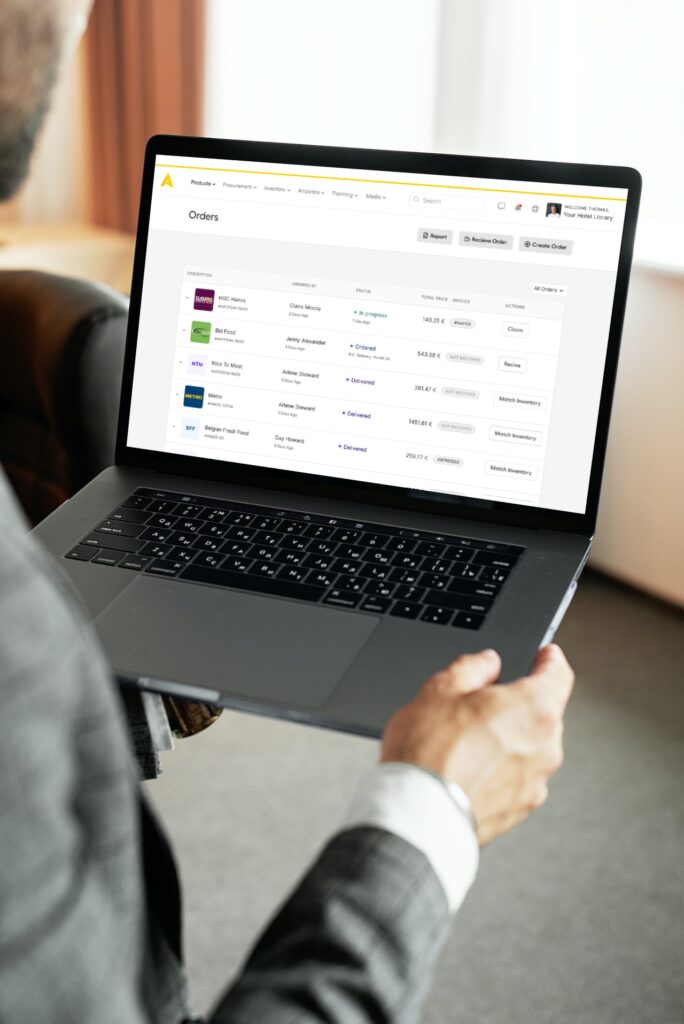
Track profitability of your cloud kitchen in real-time
With Apicbase’s end-to-end restaurant technology suite, you can optimise your menus and kitchen procedures for delivery while keeping costs down and quality up.

